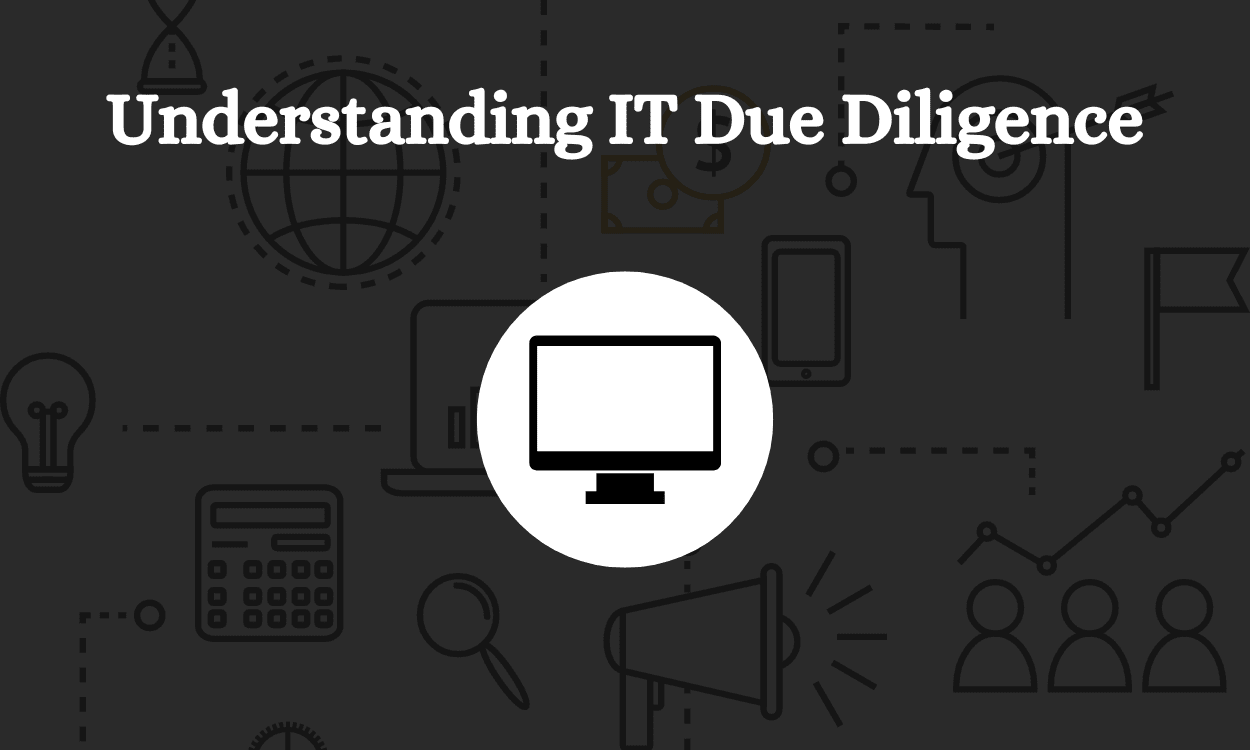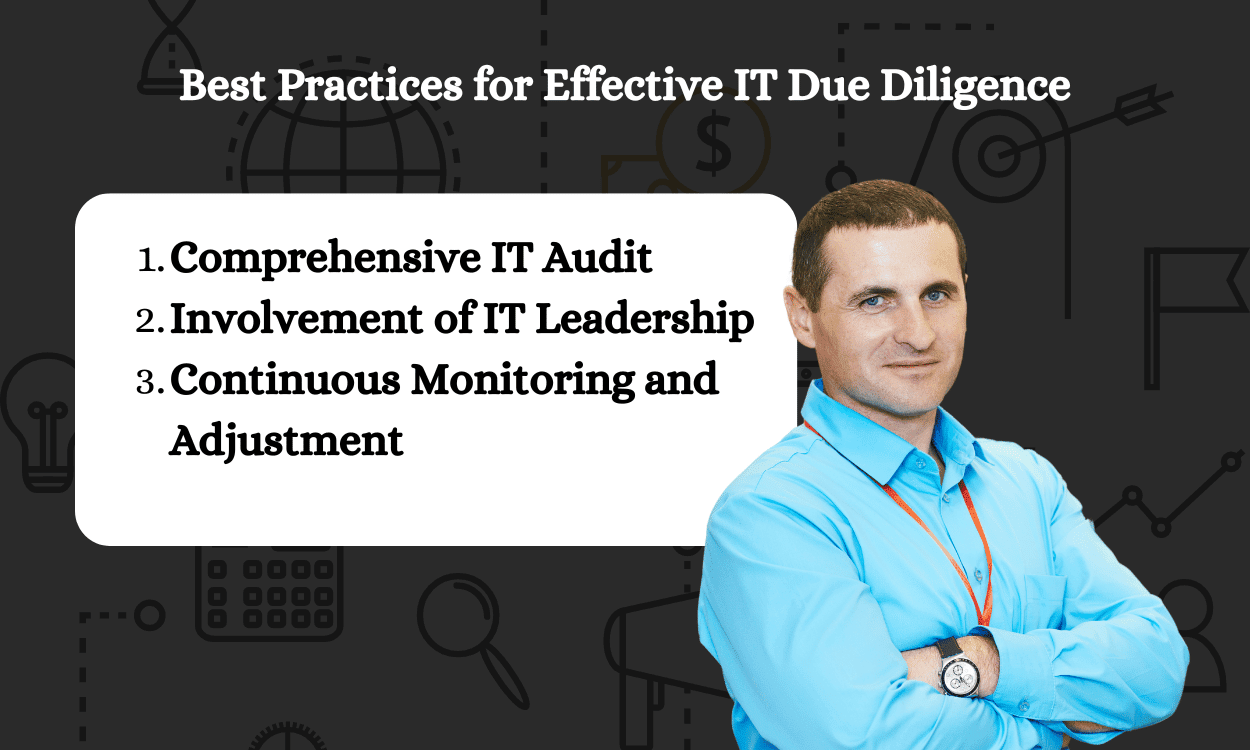The Importance of IT Due Diligence in Mergers and Acquisitions
When two companies merge, analyzing the target company’s IT infrastructure is crucial. IT due diligence is not just a checkbox; it’s an essential process that can expose hidden risks and opportunities. Conducting IT due diligence helps evaluate the target company’s technology, cybersecurity, data management practices, and IT capabilities, revealing potential pitfalls. By identifying potential deal breakers like outdated systems, non-compliance with regulations, or hidden expenses, companies can negotiate better terms, mitigate risks, and pave the way for a smoother post-merger integration.


Understanding IT Due Diligence
According to its definition, IT due diligence is fundamentally about risk assessment. We can identify vulnerabilities impacting the deal’s success by evaluating a company’s IT infrastructure, systems and processes, and their cybersecurity posture. This could include cybersecurity risks, outdated software, or insufficient data storage capabilities. These issues can lead to financial losses, legal complications, and reputational damage if not adequately addressed.
Thorough IT due diligence helps stakeholders make informed decisions by bringing potential problems to light early, allowing for proactive mitigation strategies. By understanding the target company’s technological landscape, stakeholders can negotiate better terms, allocate resources efficiently, and integrate systems more effectively post-merger. In essence, IT due diligence empowers stakeholders to minimize risks and maximize the value of the M&A transaction.

The CIO/vCIO’s Role in IT Due Diligence
In the complex world of mergers and acquisitions, the CIO or vCIO ensures a smooth and successful IT transition. Their expertise guides the process, mitigating risks and maximizing the value of the merger or acquisition. Let’s explore the multifaceted role of IT leadership in this critical phase.
Strategic Leadership and Expertise
The CIO or vCIO brings strategic leadership to the forefront of IT due diligence. They possess a deep understanding of both the acquiring company’s IT landscape and the intricacies of the target company’s systems. This unique vantage point allows them to identify potential synergies and foresee challenges that might arise during integration — or provide key insights to provide feedback to communicate about risk.
Their expertise extends beyond technical evaluation. The CIO or vCIO assesses the target company’s IT strategy and alignment with overall business goals. They evaluate the existing IT team, their capabilities, and the potential cultural impacts of the merger. By providing this strategic guidance, they pave the way for informed decision-making.
Navigating IT Systems and Infrastructure
A critical aspect of the CIO or vCIO’s role involves navigating IT systems and infrastructure complexities. They thoroughly assess hardware, software, networks, and data centers within the target company. This evaluation aims to identify any outdated technologies, data or application incompatibilities, security vulnerabilities, or potential integration roadblocks.
The CIO or vCIO also scrutinizes existing IT processes, workflows, and vendor contracts. By analyzing these elements, they can identify areas for optimization, cost savings, and potential disruptions during the merger or acquisition. This proactive approach ensures a smoother transition and minimizes the risk of business disruption.
Ensuring Compatibility and Integration
Seamless integration of IT systems is fundamental to a successful merger or acquisition. The CIO or vCIO spearheads this effort, ensuring compatibility between the two companies’ technological landscapes. They develop a comprehensive integration plan that addresses data migration, system consolidation, and the harmonization of IT policies and procedures.
They collaborate closely with IT teams to facilitate knowledge transfer and smooth employee transition. This collaborative approach minimizes friction during the integration process, enabling the newly merged entity to effectively leverage its combined IT strengths.

Key Areas of Focus During IT Due Diligence
During a merger or acquisition, IT due diligence plays a crucial role in uncovering potential risks and opportunities within the technological landscape of the target company. This process, encompassing technology due diligence, technical due diligence, and software due diligence, requires a meticulous examination of various key areas to make informed decisions. Here’s a closer look at some critical focus points during IT due diligence:
Security Assessment
In today’s digital age, security is paramount. A thorough security assessment forms the backbone of technical due diligence. This involves evaluating the target company’s cybersecurity posture, identifying vulnerabilities, and assessing potential risks. A comprehensive technology due diligence checklist should include evaluating:
- Network Security: This includes analyzing the strength of firewalls, intrusion detection systems, and overall network architecture to identify gaps in protection against unauthorized access and cyber threats.
- Data Protection: Understanding how the company handles sensitive data is crucial. Assessing data encryption methods, access controls, and data loss prevention strategies is essential to gauge the effectiveness of their data protection measures.
- Vulnerability Management: A robust program identifies and mitigates security weaknesses. Reviewing the company’s processes for identifying, assessing, and remediating vulnerabilities offers insights into its proactive security stance.
- Incident Response: It is crucial to understand the company’s incident response plan. It should outline procedures for detecting, responding to, and recovering from security incidents, minimizing potential damage and downtime.
Compliance and Regulatory Considerations
Ensuring compliance with relevant industry regulations is non-negotiable. Technical due diligence necessitates thoroughly reviewing the target company’s compliance posture. A well-structured technical due diligence checklist should include:
- Data Privacy: With regulations like GDPR and CCPA, evaluating the company’s data privacy practices is critical. Understanding their procedures for collecting, storing, and processing personal data will ensure they meet regulatory requirements.
- Industry-Specific Regulations: Depending on the company’s sector, adherence to specific industry regulations, such as HIPAA for healthcare or PCI DSS for payment card processing, is crucial. Assessing their compliance with these regulations ensures they operate within legal boundaries.
- Licensing and Certifications: Verifying the company’s software licenses, technology certifications, and compliance with relevant standards ensures it’s legally authorized to operate and provide its services.
IT Infrastructure and Operations
A comprehensive technology due diligence investigates the financial aspects of the target company’s IT infrastructure and operations. A robust technology due diligence checklist includes:
- IT Budget and Spending: Analyzing historical IT spending, understanding their current IT budget allocation, and comparing it against industry benchmarks provides insights into their financial commitment to technology.
- Return on IT Investments: Evaluating the return on investment (ROI) for past IT projects allows you to assess the effectiveness of their technology investments. This will help you understand the value generated by their technology initiatives.
- Data Due Diligence: Data due diligence is a crucial process that involves a comprehensive evaluation of a company’s data assets. It is a multi-step process that involves an in-depth assessment of available data, ensuring its health, reliability, and usability as a valuable asset in various sectors. Inadequate data due diligence can lead to financial implications, harm to brand reputation, and legal and regulatory risks, including non-compliance and data breaches. Therefore, understanding the financial implications of data quality and management is critical for making informed decisions during the M&A process.
- Future IT Investments: Understanding the company’s planned IT investments, including projected costs and potential benefits, provides insights into its technology roadmap and strategic vision. This helps align their technological direction with the acquiring company’s goals.
Focusing on these critical areas during the IT due diligence process enables businesses to understand the target company’s technological landscape comprehensively. This enables them to uncover potential risks, capitalize on opportunities, and make informed decisions that maximize value during a merger or acquisition.

Best Practices for Effective IT Due Diligence
Successfully navigating the complexities of IT due diligence in mergers and acquisitions requires a structured and comprehensive approach. Let’s explore some best practices that can ensure a smoother and more insightful process.
Comprehensive IT Audit
A thorough and meticulous IT audit is a cornerstone of effective IT due diligence. This audit should encompass all facets of the target company’s IT infrastructure, systems, and processes. It should meticulously evaluate:
- Infrastructure: A comprehensive review of hardware, software, network architecture, and data centers.
- Security Posture: A rigorous assessment of security protocols, data protection mechanisms, and vulnerability management practices.
- Applications and Data: Analysis of critical applications, data governance practices, and compliance with relevant data privacy regulations.
- IT Processes: An evaluation of IT service management, incident response, and disaster recovery plans.
Conducting this in-depth audit can help you comprehensively understand the target company’s IT landscape, identify potential risks and opportunities, and inform crucial decisions regarding integration and future investment.
Involvement of IT Leadership
Engaging IT leadership in acquiring and targeting companies is paramount throughout IT due diligence. Early involvement of CIOs or vCIOs ensures strategic alignment and facilitates a more seamless transition. Their expertise is crucial in:
- Defining the Scope of the Audit: IT leaders are best equipped to determine the specific areas that require close examination based on the nature of the merger or acquisition.
- Interpreting Audit Findings: CIOs and vCIOs can provide insightful context and analysis of the technical findings, translating complex technical details into strategic business implications.
- Developing Integration Plans: Their understanding of both IT systems allows them to design effective strategies for merging infrastructures and applications while minimizing disruptions.
Continuous Monitoring and Adjustment
IT due diligence is not a one-time event but an ongoing process. The IT landscape constantly evolves, and new risks and opportunities can emerge after the initial due diligence phase. Continuous monitoring is essential to:
- Track Integration Progress: Regularly assess the integration of IT systems and infrastructure, addressing any unforeseen challenges or delays that may arise.
- Identify Emerging Risks: Stay vigilant for new cybersecurity threats, regulatory changes, and technology advancements that may impact the merged entity.
- Optimize IT Investments: Continuously evaluate the efficiency and effectiveness of IT investments, making necessary adjustments to optimize resource allocation and support business objectives.
Organizations can ensure a more thorough and insightful IT due diligence process by implementing these best practices. This proactive approach helps mitigate risks, uncover hidden opportunities, and pave the way for a successful and value-driven merger or acquisition.
Need Some IT Support?
Conclusion: Maximizing Value Through Effective IT Due Diligence
IT due diligence is critical in ensuring a successful transition and maximizing value for all stakeholders involved in the complex world of mergers and acquisitions. By thoroughly assessing the target company’s IT infrastructure, systems, and security posture, organizations can mitigate potential risks and capitalize on opportunities for synergy and growth.
Neglecting this essential process can expose companies to unforeseen challenges, leading to financial losses, operational disruptions, and repetitional damage. Embracing IT due diligence, however, enables informed decision-making, streamlines integration, and unlocks the combined entity’s full potential in the long run.
Consult with a vCIO Today
Mergers and acquisitions are complex. That’s why seeking guidance from technology due diligence consulting experts is essential for navigating the technological landscape of M&A. A virtual Chief Information Officer (vCIO) brings experience and specialized knowledge. They provide valuable insights that can make or break your deal.
Don’t leave the success of your M&A to chance. Contact a vCIO today, and let their expertise ensure a seamless transition.

